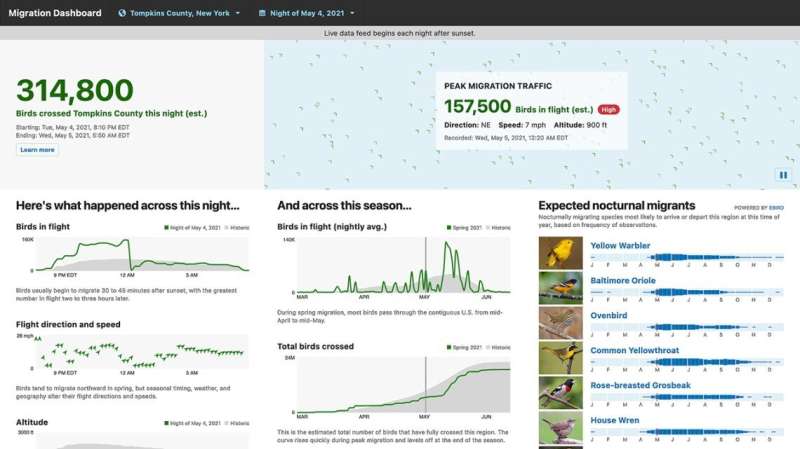Dashboard reveals migration paths of billions of birds

The BirdCast program at the Cornell Lab of Ornithology is exploring bird migration—one of the greatest, mostly unseen spectacles of nature—with its new Migration Dashboard, which reveals bird movements in localized detail previously unavailable to the general public.
"With this new Migration Dashboard, you get facts and figures about what's going on in the skies above you at the county level in near-real time," said Andrew Farnsworth, senior researcher with BirdCast. "In recent years, we've been able to visualize and forecast the movements of migrating birds on a continent-wide scale, using weather surveillance radar.
"That's been fascinating, but now you can also get a feel for what's going on in your own neck of the woods," he said. "We want to elevate people's abilities to understand bird migration, to talk about migration. There is tremendous potential for learning here. We don't come close to knowing all the patterns that you will be able to explore when you look at this tool."
Billions of birds make their migratory journeys under cover of darkness. Now, the dashboard can show how many birds are estimated to have flown over a particular county in the lower 48 states on any given night during migration, updated in near-real time.
It shows how many birds are currently aloft, how fast they are going, what direction they are headed, how high they're flying and how the ebb and flow of their movements during the night compares with historic patterns. Users can also catch up with the previous night's activity the next day.
The dashboard uses weather surveillance radar to measure the density of a mass of birds. That measure is then turned into an estimate of numbers.
"One of the most compelling things about the new dashboard is that it's focusing on a phenomenon that is largely taking place out of sight and most likely when we're asleep," said Audrey Carlsen, who led the dashboard's design and development. "Massive quantities of living creatures are flying through the night sky. This is our best tool right now to try to understand migration."
Knowing the who, where and when of migration can help biologists, conservationists and nature lovers protect birds. For example, the data can guide decisions about which nights to turn off lights so birds aren't attracted to buildings and don't collide with them, or where to build wind turbines to avoid killing birds.
"I can't wait to see the effect the BirdCast Migration Dashboard will have when people are able to see detailed migration information for their own county," said Ian Owens, executive director of the Cornell Lab. "I can't think of a better catalyst for people to find ways to protect those species and habitats."
More information: BirdCast: birdcast.info/
Provided by Cornell University





















